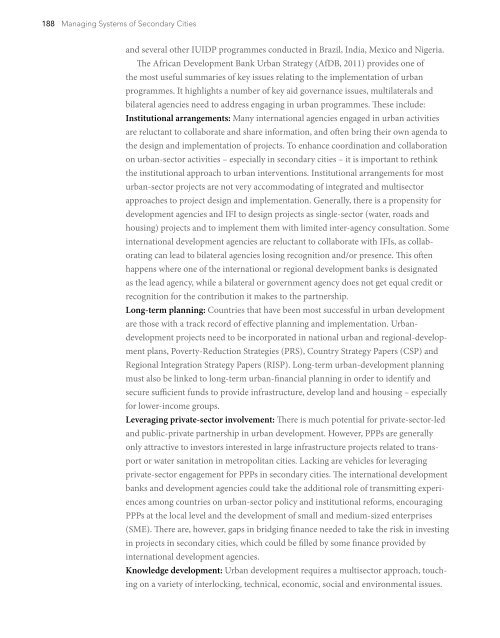DYhWN
DYhWN
DYhWN
You also want an ePaper? Increase the reach of your titles
YUMPU automatically turns print PDFs into web optimized ePapers that Google loves.
188 Managing Systems of Secondary Citiesand several other IUIDP programmes conducted in Brazil, India, Mexico and Nigeria.The African Development Bank Urban Strategy (AfDB, 2011) provides one ofthe most useful summaries of key issues relating to the implementation of urbanprogrammes. It highlights a number of key aid governance issues, multilaterals andbilateral agencies need to address engaging in urban programmes. These include:Institutional arrangements: Many international agencies engaged in urban activitiesare reluctant to collaborate and share information, and often bring their own agenda tothe design and implementation of projects. To enhance coordination and collaborationon urban-sector activities – especially in secondary cities – it is important to rethinkthe institutional approach to urban interventions. Institutional arrangements for mosturban-sector projects are not very accommodating of integrated and multisectorapproaches to project design and implementation. Generally, there is a propensity fordevelopment agencies and IFI to design projects as single-sector (water, roads andhousing) projects and to implement them with limited inter-agency consultation. Someinternational development agencies are reluctant to collaborate with IFIs, as collaboratingcan lead to bilateral agencies losing recognition and/or presence. This oftenhappens where one of the international or regional development banks is designatedas the lead agency, while a bilateral or government agency does not get equal credit orrecognition for the contribution it makes to the partnership.Long-term planning: Countries that have been most successful in urban developmentare those with a track record of effective planning and implementation. Urbandevelopmentprojects need to be incorporated in national urban and regional-developmentplans, Poverty-Reduction Strategies (PRS), Country Strategy Papers (CSP) andRegional Integration Strategy Papers (RISP). Long-term urban-development planningmust also be linked to long-term urban-financial planning in order to identify andsecure sufficient funds to provide infrastructure, develop land and housing – especiallyfor lower-income groups.Leveraging private-sector involvement: There is much potential for private-sector-ledand public-private partnership in urban development. However, PPPs are generallyonly attractive to investors interested in large infrastructure projects related to transportor water sanitation in metropolitan cities. Lacking are vehicles for leveragingprivate-sector engagement for PPPs in secondary cities. The international developmentbanks and development agencies could take the additional role of transmitting experiencesamong countries on urban-sector policy and institutional reforms, encouragingPPPs at the local level and the development of small and medium-sized enterprises(SME). There are, however, gaps in bridging finance needed to take the risk in investingin projects in secondary cities, which could be filled by some finance provided byinternational development agencies.Knowledge development: Urban development requires a multisector approach, touchingon a variety of interlocking, technical, economic, social and environmental issues.


